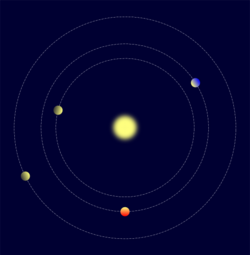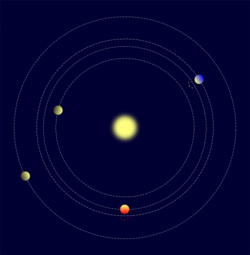Astronomy:Kepler-223
| Observation data Equinox J2000.0]] (ICRS) | |
|---|---|
| Constellation | Cygnus |
| Right ascension | 19h 53m 16.4203s[1] |
| Declination | +47° 16′ 46.3081″[1] |
| Characteristics | |
| Apparent magnitude (g) | 15.903[2] |
| Apparent magnitude (r) | 15.301[2] |
| Apparent magnitude (i) | 15.105[2] |
| Apparent magnitude (z) | 14.963[2] |
| Apparent magnitude (D51) | 15.667[2] |
| Apparent magnitude (J) | 14.095[2] |
| Apparent magnitude (H) | 13.727[2] |
| Apparent magnitude (K) | 13.632[2] |
| J−K color index | 0.463[2] |
| Characteristics | |
| Spectral type | G[3] |
| Astrometry | |
| Proper motion (μ) | RA: −4.270±0.055[1] mas/yr Dec.: −11.068±0.051[1] mas/yr |
| Parallax (π) | 0.5101 ± 0.0313[1] mas |
| Distance | 6,400 ± 400 ly (2,000 ± 100 pc) |
| Details | |
| Radius | 1.095[2] R☉ |
| Surface gravity (log g) | 4.386[2] cgs |
| Temperature | 5,599[2] K |
| Metallicity | -0.211[2] |
| Other designations | |
| Database references | |
| SIMBAD | data |
| KIC | data |
Kepler-223 (KOI-730, KIC 10227020) is a G5V star with an extrasolar planetary system discovered by the Kepler mission. Studies indicate that the Kepler-223 star system consists of 4 planets orbiting the star.[5][3]
Planetary system
| Companion (in order from star) |
Mass | Semimajor axis (AU) |
Orbital period (days) |
Eccentricity | Inclination | Radius |
|---|---|---|---|---|---|---|
| b | — | — | 7.3845 | — | — | 3 R⊕ |
| c | — | — | 9.8456 | — | — | 3.4 R⊕ |
| d | — | — | 14.7887 | — | — | 5.2 R⊕ |
| e | — | — | 19.7257 | — | — | 4.6 R⊕ |
The confirmed planetary system was first detected by the Kepler mission, and contains four planets.[6] This system was initially believed to contain two co-orbital planets orbiting the star at approximately the same orbital distance every 9.8 days, with one permanently locked 60° behind the other in one of the two Trojan Lagrangian points.[7] The two co-orbital planets were thought to be locked in mean motion resonances with the other two planets, creating an overall 6:4:4:3 resonance.[8] This would have been the first known example of co-orbital planets.
However, follow-up study of the system revealed that an alternative configuration, with the four planets having orbital periods in the ratio 8:6:4:3 is better supported by the data. This configuration does not contain co-orbital planets,[9] and has been confirmed by further observations.[3] It represents the first confirmed 4-body orbital resonance.[6]
The radii are 3.0, 3.4, 5.2, and 4.6 Earth radii, and the orbital periods are 7.3845, 9.8456, 14.7887 and 19.7257 days, respectively.[3]
See also
References
- ↑ 1.0 1.1 1.2 1.3 1.4 Brown, A. G. A. (August 2018). "Gaia Data Release 2: Summary of the contents and survey properties". Astronomy & Astrophysics 616: A1. doi:10.1051/0004-6361/201833051. Bibcode: 2018A&A...616A...1G. Gaia DR2 record for this source at VizieR.
- ↑ 2.00 2.01 2.02 2.03 2.04 2.05 2.06 2.07 2.08 2.09 2.10 2.11 2.12 "KIC10 Search". Multimission Archive at STScI. 8 October 2009. http://archive.stsci.edu/kepler/kic10/search.php.
- ↑ 3.0 3.1 3.2 3.3 Mills, S. M.; Fabrycky, D. C.; Migaszewski, C.; Ford, E. B.; Petigura, E.; Isaacson, H. (2016-05-11). "A resonant chain of four transiting, sub-Neptune planets". Nature 533 (7604): 509–512. doi:10.1038/nature17445. PMID 27225123. Bibcode: 2016Natur.533..509M.
- ↑ "Kepler-223". SIMBAD. Centre de données astronomiques de Strasbourg. http://simbad.u-strasbg.fr/simbad/sim-basic?Ident=Kepler-223.
- ↑ Borucki, William J.; Koch, David G.; Basri, Gibor; Batalha, Natalie; Brown, Timothy M.; Bryson, Stephen T.; Caldwell, Douglas; Christensen-Dalsgaard, Jørgen et al. (2011). "Characteristics of planetary candidates observed by Kepler, II: Analysis of the first four months of data". The Astrophysical Journal 736 (1): 19. doi:10.1088/0004-637X/736/1/19. Bibcode: 2011ApJ...736...19B.
- ↑ 6.0 6.1 Koppes, S. (2016-05-17). "Kepler-223 System: Clues to Planetary Migration". http://www.jpl.nasa.gov/news/news.php?feature=6515.
- ↑ Chown, Marcus (28 February 2011). "Two planets found sharing one orbit". New Scientist. https://www.newscientist.com/article/dn20160-two-planets-found-sharing-one-orbit.html.
- ↑ Emspak, Jesse (2 March 2011). "Kepler Finds Bizarre Systems". International Business Times. International Business Times Inc.. http://www.ibtimes.com/articles/117984/20110302/kepler-finds-strange-worlds-fastest-planet.htm.
- ↑ Beatty, Kelly (5 March 2011). "Kepler Finds Planets in Tight Dance". Sky and Telescope. http://www.skyandtelescope.com/astronomy-news/kepler-finds-planets-in-tight-dance/.
External links
- "Planetary System KOI-730 Exhibiting a Pair of Co-Orbital Planets" (this site requires a browser with support for WebGL)
- 2MASS Catalog Retrieval
Coordinates: ![]() 19h 53m 16.40s, +47° 16′ 46.2″
19h 53m 16.40s, +47° 16′ 46.2″
 |



